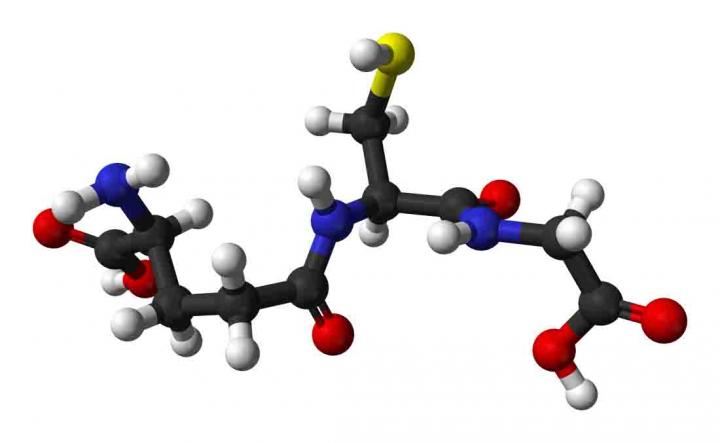Boosting levels of antioxidant may help resist age-related decline
October 28, 2016

The chemical structure of glutathione, an antioxidant that may help resist the toxins that are an underlying cause of aging. (credit: Oregon State University)
Researchers at Oregon State University have found evidence in a rat study* that levels of glutathione, which helps resist the toxic stresses of everyday life, decline with age, and this sets the stage for a wide range of age-related health problems, they suggest.
The new study, published in the journal Redox Biology, also highlighted a compound called N-acetyl-cysteine (NAC), which is used in high doses in medical detoxification emergencies to help patients in a toxic crisis, such as ingestion of poisonous levels of heavy metals or acetaminophen overdose.
NAC, the researchers said, is known to boost the metabolic function of glutathione and increase its rate of synthesis. In the study, pretreatment with NAC increased glutathione levels in the older cells and largely helped offset the level of cell death.
But the researchers said that at much lower levels, NAC might also help maintain glutathione levels and prevent the routine metabolic declines associated with aging.
Aging-related decline of these detoxification pathways, the scientists say, are linked to cardiovascular disease, diabetes and cancer, some of the primary causes of death in the developed world.
“We’ve known for some time of the importance of glutathione as a strong antioxidant,” said Tory Hagen, lead author on the research and the Helen P. Rumbel Professor for Health Aging Research in the Linus Pauling Institute at OSU.
Detoxing with glutathione
“What this study pointed out was the way that cells from younger animals are far more resistant to stress than those from older animals. In young animal cells, stress doesn’t cause such a rapid loss of glutathione. The cells from older animals, on the other hand, were quickly depleted of glutathione and died twice as fast when subjected to stress.
According to Hagen, glutathione is such an important antioxidant that its existence appears to date back as far as oxygen-dependent, or aerobic life itself — about 1.5 billion years. It’s a principal compound to detoxify environmental stresses, air pollutants, heavy metals, pharmaceuticals and many other toxic insults.
“I’m optimistic there could be a role for this compound in preventing the increased toxicity we face with aging, as our abilities to deal with toxins decline,” Hagen said. “We might be able to improve the metabolic resilience that we’re naturally losing with age.”
Hagen suggested that higher levels of glutathione — boosted by NAC — might also help reduce the toxicity of some prescription drugs, cancer chemotherapies, and treat other health issues.
This research was supported by the National Institutes of Health, the National Science Foundation, and the Medical Research Foundation of Oregon.
* In this study, scientists tried to identify the resistance to toxins of young cells, compared to those of older cells. They used a toxic compound called menadione to stress the cells, and in the face of that stress, the younger cells lost significantly less of their glutathione than older cells did. The glutathione levels of young rat cells never decreased to less than 35 percent of its initial level, whereas in older rat cells glutathione levels plummeted to 10 percent of their original level.
Abstract of Glutathione maintenance mitigates age-related susceptibility to redox cycling agents
Isolated hepatocytes from young (4–6 mo) and old (24–26 mo) F344 rats were exposed to increasing concentrations of menadione, a vitamin K derivative and redox cycling agent, to determine whether the age-related decline in Nrf2-mediated detoxification defenses resulted in heightened susceptibility to xenobiotic insult. An LC50 for each age group was established, which showed that aging resulted in a nearly 2-fold increase in susceptibility to menadione (LC50 for young: 405 μM; LC50 for old: 275 μM). Examination of the known Nrf2-regulated pathways associated with menadione detoxification revealed, surprisingly, that NAD(P)H: quinone oxido-reductase 1 (NQO1) protein levels and activity were induced 9-fold and 4-fold with age, respectively (p=0.0019 and p=0.018; N=3), but glutathione peroxidase 4 (GPX4) declined by 70% (p=0.0043; N=3). These results indicate toxicity may stem from vulnerability to lipid peroxidation instead of inadequate reduction of menadione semi-quinone. Lipid peroxidation was 2-fold higher, and GSH declined by a 3-fold greater margin in old versus young rat cells given 300 µM menadione (p<0.05 and p≤0.01 respectively; N=3). We therefore provided 400 µM N-acetyl-cysteine (NAC) to hepatocytes from old rats before menadione exposure to alleviate limits in cysteine substrate availability for GSH synthesis during challenge. NAC pretreatment resulted in a >2-fold reduction in cell death, suggesting that the age-related increase in menadione susceptibility likely stems from attenuated GSH-dependent defenses. This data identifies cellular targets for intervention in order to limit age-related toxicological insults to menadione and potentially other redox cycling compounds.